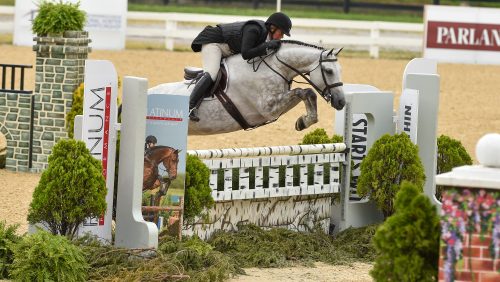I’ve always enjoyed cooking, but I seldom have the time to experiment and try new recipes. So sometimes in the evenings I tune into Emeril Live on the Food Network, a TV show featuring master chef Emeril Lagasse, for inspiration and ideas.
When I found some extra time this past weekend, I opened the recipe books, drove to the grocery store and decided to expand my (admittedly limited) culinary resume.
And while I was waiting for my ingredients to saut�, I thought about the similarities between cooking and horses. True gourmet chefs love the process of starting out with an array of raw ingredients, combining them in various ways, and presenting them on a perfectly adorned table to an eager diner.
So it is with horses. Our ingredients differ, but the process is remarkably similar.
Where Emeril would base his recipe for “Fettuccini Alfredo With Prosciutto and Peas” with fresh fettuccini, we horsemen begin our recipe for a show horse with a pedigree. While Emeril could use another type of pasta and it might taste almost as good, fettuccini is the obvious choice. Its flatter shape allows thick sauces, such as alfredo, to cling to the pasta. Likewise, a horseman could choose a prominent dressage horse to sire his next show hunter, but the horse might not jump as well as one by a proven conformation hunter, such as Popeye K.
So, once Emeril has selected the proper pasta, he collects his cooking utensils, measures his other ingredients and prepares them for cooking. Similarly, once a horseman has his prospect, he provides a place for the horse to live, a trainer, veterinarian and farrier. He assembles the tack and equipment and is ready to start to work.
Most of Emeril’s time spent on this recipe is saut�ing shallots and garlic, then combining the cream, melting the cheese and heating the peas and prosciutto. Cooking the pasta takes just a few minutes when it’s fresh.
ADVERTISEMENT
A horseman would spend most of his time on flatwork and gymnastics, training the horse to his aids, building fitness and establishing a rapport with him. The actual time spent jumping fences is like fresh pasta–it takes just a small amount of time compared to the rest of the recipe.
Then, when the sauce is thick and creamy, and the pasta al dente, Emeril tosses them in skillet to combine. He then garnishes the dish with extra cheese, salt and pepper, and serves immediately.
When the horseman believes his horse is prepared, he’ll take him to a show. He’ll combine the flatwork, gymnastics and jumping skills the horse mastered at home, add a bit of hoof polish, garnish with braids, and the horse will enter the ring ready to serve the judge with a tasteful performance.
It sounds easy, doesn’t it? With this analogy, it’s fun to imagine Emeril’s finished dish was rich and delicious, served with a crusty loaf of bread, and our show hunter cantered confidently around, jumped with beautiful form, and won his first blue ribbon.
In reality, the final step is where our comparison most likely ends. Emeril’s recipe is rated “easy” on his three-tier scale of difficulty. I’ve never tried a green prospect yet that wore a label describing him as easy, medium or expert. Unlike cooks, we horsemen have to follow our recipe and decide the difficulty factor much later–and we just cross our fingers and hope that the horse doesn’t become one of those described as “expert.”
Tricia Booker














